[English] 日本語
 Yorodumi
Yorodumi- PDB-6g0r: Crystal Structure of the first bromodomain of human BRD4 in compl... -
+ Open data
Open data
- Basic information
Basic information
| Entry | Database: PDB / ID: 6g0r | ||||||
|---|---|---|---|---|---|---|---|
| Title | Crystal Structure of the first bromodomain of human BRD4 in complex with an acetylated POLR2A peptide (K775ac/K778ac) | ||||||
 Components Components |
| ||||||
 Keywords Keywords | TRANSCRIPTION / Bromodomain / complex | ||||||
| Function / homology |  Function and homology information Function and homology informationmicrofibril binding / Abortive elongation of HIV-1 transcript in the absence of Tat / FGFR2 alternative splicing / MicroRNA (miRNA) biogenesis / Viral Messenger RNA Synthesis / Signaling by FGFR2 IIIa TM / RNA Pol II CTD phosphorylation and interaction with CE during HIV infection / RNA Pol II CTD phosphorylation and interaction with CE / HIV Transcription Initiation / RNA Polymerase II HIV Promoter Escape ...microfibril binding / Abortive elongation of HIV-1 transcript in the absence of Tat / FGFR2 alternative splicing / MicroRNA (miRNA) biogenesis / Viral Messenger RNA Synthesis / Signaling by FGFR2 IIIa TM / RNA Pol II CTD phosphorylation and interaction with CE during HIV infection / RNA Pol II CTD phosphorylation and interaction with CE / HIV Transcription Initiation / RNA Polymerase II HIV Promoter Escape / Transcription of the HIV genome / RNA Polymerase II Promoter Escape / RNA Polymerase II Transcription Pre-Initiation And Promoter Opening / RNA Polymerase II Transcription Initiation / RNA Polymerase II Transcription Initiation And Promoter Clearance / Formation of the Early Elongation Complex / Formation of the HIV-1 Early Elongation Complex / mRNA Capping / mRNA Splicing - Minor Pathway / PIWI-interacting RNA (piRNA) biogenesis / RNA polymerase II C-terminal domain binding / P-TEFb complex binding / Processing of Capped Intron-Containing Pre-mRNA / negative regulation of DNA damage checkpoint / histone H4 reader activity / Pausing and recovery of Tat-mediated HIV elongation / Tat-mediated HIV elongation arrest and recovery / RNA polymerase II transcribes snRNA genes / HIV elongation arrest and recovery / Pausing and recovery of HIV elongation / host-mediated suppression of viral transcription / positive regulation of G2/M transition of mitotic cell cycle / positive regulation of T-helper 17 cell lineage commitment / Tat-mediated elongation of the HIV-1 transcript / Formation of HIV-1 elongation complex containing HIV-1 Tat / Formation of HIV elongation complex in the absence of HIV Tat / RNA polymerase II, core complex / RNA Polymerase II Transcription Elongation / Formation of RNA Pol II elongation complex / : / RNA Polymerase II Pre-transcription Events / RNA polymerase II CTD heptapeptide repeat kinase activity / mRNA Splicing - Major Pathway / Inhibition of DNA recombination at telomere / positive regulation of RNA splicing / condensed nuclear chromosome / transcription coregulator activity / TP53 Regulates Transcription of DNA Repair Genes / promoter-specific chromatin binding / positive regulation of transcription elongation by RNA polymerase II / Transcriptional regulation by small RNAs / DNA-templated transcription termination / Transcription-Coupled Nucleotide Excision Repair (TC-NER) / Formation of TC-NER Pre-Incision Complex / kinase binding / Activation of anterior HOX genes in hindbrain development during early embryogenesis / DNA-directed RNA polymerase / Dual incision in TC-NER / Gap-filling DNA repair synthesis and ligation in TC-NER / p53 binding / DNA-directed RNA polymerase activity / chromosome / regulation of inflammatory response / Hydrolases; Acting on ester bonds; Exoribonucleases producing 5'-phosphomonoesters / histone binding / Estrogen-dependent gene expression / Potential therapeutics for SARS / transcription by RNA polymerase II / transcription coactivator activity / positive regulation of canonical NF-kappaB signal transduction / transcription cis-regulatory region binding / hydrolase activity / chromatin remodeling / RNA-directed RNA polymerase / RNA-directed RNA polymerase activity / protein serine/threonine kinase activity / DNA damage response / ubiquitin protein ligase binding / chromatin binding / regulation of DNA-templated transcription / regulation of transcription by RNA polymerase II / chromatin / positive regulation of DNA-templated transcription / enzyme binding / magnesium ion binding / positive regulation of transcription by RNA polymerase II / mitochondrion / DNA binding / RNA binding / zinc ion binding / nucleoplasm / nucleus Similarity search - Function | ||||||
| Biological species |  Homo sapiens (human) Homo sapiens (human) | ||||||
| Method |  X-RAY DIFFRACTION / X-RAY DIFFRACTION /  SYNCHROTRON / SYNCHROTRON /  MOLECULAR REPLACEMENT / MOLECULAR REPLACEMENT /  molecular replacement / Resolution: 1.25 Å molecular replacement / Resolution: 1.25 Å | ||||||
 Authors Authors | Filippakopoulos, P. / Picaud, S. / Pike, A.C.W. / von Delft, F. / Arrowsmith, C.H. / Edwards, A.M. / Bountra, C. | ||||||
| Funding support |  United Kingdom, 1items United Kingdom, 1items
| ||||||
 Citation Citation |  Journal: Mol Cell / Year: 2019 Journal: Mol Cell / Year: 2019Title: Interactome Rewiring Following Pharmacological Targeting of BET Bromodomains. Authors: Jean-Philippe Lambert / Sarah Picaud / Takao Fujisawa / Huayun Hou / Pavel Savitsky / Liis Uusküla-Reimand / Gagan D Gupta / Hala Abdouni / Zhen-Yuan Lin / Monika Tucholska / James D R ...Authors: Jean-Philippe Lambert / Sarah Picaud / Takao Fujisawa / Huayun Hou / Pavel Savitsky / Liis Uusküla-Reimand / Gagan D Gupta / Hala Abdouni / Zhen-Yuan Lin / Monika Tucholska / James D R Knight / Beatriz Gonzalez-Badillo / Nicole St-Denis / Joseph A Newman / Manuel Stucki / Laurence Pelletier / Nuno Bandeira / Michael D Wilson / Panagis Filippakopoulos / Anne-Claude Gingras /      Abstract: Targeting bromodomains (BRDs) of the bromo-and-extra-terminal (BET) family offers opportunities for therapeutic intervention in cancer and other diseases. Here, we profile the interactomes of BRD2, ...Targeting bromodomains (BRDs) of the bromo-and-extra-terminal (BET) family offers opportunities for therapeutic intervention in cancer and other diseases. Here, we profile the interactomes of BRD2, BRD3, BRD4, and BRDT following treatment with the pan-BET BRD inhibitor JQ1, revealing broad rewiring of the interaction landscape, with three distinct classes of behavior for the 603 unique interactors identified. A group of proteins associate in a JQ1-sensitive manner with BET BRDs through canonical and new binding modes, while two classes of extra-terminal (ET)-domain binding motifs mediate acetylation-independent interactions. Last, we identify an unexpected increase in several interactions following JQ1 treatment that define negative functions for BRD3 in the regulation of rRNA synthesis and potentially RNAPII-dependent gene expression that result in decreased cell proliferation. Together, our data highlight the contributions of BET protein modules to their interactomes allowing for a better understanding of pharmacological rewiring in response to JQ1. | ||||||
| History |
|
- Structure visualization
Structure visualization
| Structure viewer | Molecule:  Molmil Molmil Jmol/JSmol Jmol/JSmol |
|---|
- Downloads & links
Downloads & links
- Download
Download
| PDBx/mmCIF format |  6g0r.cif.gz 6g0r.cif.gz | 77.8 KB | Display |  PDBx/mmCIF format PDBx/mmCIF format |
|---|---|---|---|---|
| PDB format |  pdb6g0r.ent.gz pdb6g0r.ent.gz | 56 KB | Display |  PDB format PDB format |
| PDBx/mmJSON format |  6g0r.json.gz 6g0r.json.gz | Tree view |  PDBx/mmJSON format PDBx/mmJSON format | |
| Others |  Other downloads Other downloads |
-Validation report
| Summary document |  6g0r_validation.pdf.gz 6g0r_validation.pdf.gz | 437.1 KB | Display |  wwPDB validaton report wwPDB validaton report |
|---|---|---|---|---|
| Full document |  6g0r_full_validation.pdf.gz 6g0r_full_validation.pdf.gz | 437.1 KB | Display | |
| Data in XML |  6g0r_validation.xml.gz 6g0r_validation.xml.gz | 8.9 KB | Display | |
| Data in CIF |  6g0r_validation.cif.gz 6g0r_validation.cif.gz | 12.2 KB | Display | |
| Arichive directory |  https://data.pdbj.org/pub/pdb/validation_reports/g0/6g0r https://data.pdbj.org/pub/pdb/validation_reports/g0/6g0r ftp://data.pdbj.org/pub/pdb/validation_reports/g0/6g0r ftp://data.pdbj.org/pub/pdb/validation_reports/g0/6g0r | HTTPS FTP |
-Related structure data
| Related structure data | 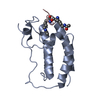 5nncC 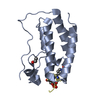 5nndC  5nneC  5nnfC  5nngC  6g0oC  6g0pC  6g0qC 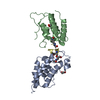 6g0sC  2grcS 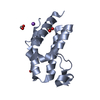 2oo1S 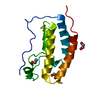 2ossS 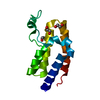 2ouoS 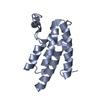 3d7cS 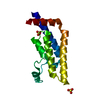 3daiS 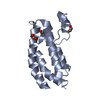 3dwyS S: Starting model for refinement C: citing same article ( |
|---|---|
| Similar structure data |
- Links
Links
- Assembly
Assembly
| Deposited unit | 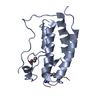
| ||||||||
|---|---|---|---|---|---|---|---|---|---|
| 1 |
| ||||||||
| Unit cell |
|
- Components
Components
| #1: Protein | Mass: 15099.380 Da / Num. of mol.: 1 Source method: isolated from a genetically manipulated source Source: (gene. exp.)  Homo sapiens (human) / Gene: BRD4, HUNK1 / Plasmid: pNIC28-Bsa4 / Production host: Homo sapiens (human) / Gene: BRD4, HUNK1 / Plasmid: pNIC28-Bsa4 / Production host:  |
|---|---|
| #2: Protein/peptide | Mass: 1221.362 Da / Num. of mol.: 1 / Source method: obtained synthetically Details: POLR2A peptide acetylated at K775 and K778 C-terminal TYR added for UV detection Source: (synth.)  Homo sapiens (human) Homo sapiens (human)References: UniProt: P24928, DNA-directed RNA polymerase, RNA-directed RNA polymerase |
| #3: Chemical | ChemComp-EDO / |
| #4: Water | ChemComp-HOH / |
| Has protein modification | Y |
-Experimental details
-Experiment
| Experiment | Method:  X-RAY DIFFRACTION / Number of used crystals: 1 X-RAY DIFFRACTION / Number of used crystals: 1 |
|---|
- Sample preparation
Sample preparation
| Crystal | Density Matthews: 2.08 Å3/Da / Density % sol: 40.81 % |
|---|---|
| Crystal grow | Temperature: 277 K / Method: vapor diffusion, sitting drop / pH: 7 Details: 20.0 % PEG 6K 10.0 % EtGly 0.1 M HEPES pH 7.0 0.1 M MgCl2 |
-Data collection
| Diffraction | Mean temperature: 100 K | |||||||||||||||||||||||||||||||||||||||||||||||||||||||||||||||||||||||||||||||||||||||||||||||||||
|---|---|---|---|---|---|---|---|---|---|---|---|---|---|---|---|---|---|---|---|---|---|---|---|---|---|---|---|---|---|---|---|---|---|---|---|---|---|---|---|---|---|---|---|---|---|---|---|---|---|---|---|---|---|---|---|---|---|---|---|---|---|---|---|---|---|---|---|---|---|---|---|---|---|---|---|---|---|---|---|---|---|---|---|---|---|---|---|---|---|---|---|---|---|---|---|---|---|---|---|---|
| Diffraction source | Source:  SYNCHROTRON / Site: SYNCHROTRON / Site:  Diamond Diamond  / Beamline: I24 / Wavelength: 0.9686 Å / Beamline: I24 / Wavelength: 0.9686 Å | |||||||||||||||||||||||||||||||||||||||||||||||||||||||||||||||||||||||||||||||||||||||||||||||||||
| Detector | Type: DECTRIS PILATUS 6M-F / Detector: PIXEL / Date: May 14, 2016 | |||||||||||||||||||||||||||||||||||||||||||||||||||||||||||||||||||||||||||||||||||||||||||||||||||
| Radiation | Protocol: SINGLE WAVELENGTH / Monochromatic (M) / Laue (L): M / Scattering type: x-ray | |||||||||||||||||||||||||||||||||||||||||||||||||||||||||||||||||||||||||||||||||||||||||||||||||||
| Radiation wavelength | Wavelength: 0.9686 Å / Relative weight: 1 | |||||||||||||||||||||||||||||||||||||||||||||||||||||||||||||||||||||||||||||||||||||||||||||||||||
| Reflection | Resolution: 1.25→58.52 Å / Num. obs: 37495 / % possible obs: 99.9 % / Redundancy: 5.1 % / Rmerge(I) obs: 0.142 / Rpim(I) all: 0.068 / Rrim(I) all: 0.158 / Rsym value: 0.142 / Net I/av σ(I): 1.8 / Net I/σ(I): 7.3 | |||||||||||||||||||||||||||||||||||||||||||||||||||||||||||||||||||||||||||||||||||||||||||||||||||
| Reflection shell | Diffraction-ID: 1
|
-Phasing
| Phasing | Method:  molecular replacement molecular replacement | |||||||||
|---|---|---|---|---|---|---|---|---|---|---|
| Phasing MR | Model details: Phaser MODE: MR_AUTO
|
- Processing
Processing
| Software |
| |||||||||||||||||||||||||||||||||||||||||||||||||||||||||||||||||||||||||||
|---|---|---|---|---|---|---|---|---|---|---|---|---|---|---|---|---|---|---|---|---|---|---|---|---|---|---|---|---|---|---|---|---|---|---|---|---|---|---|---|---|---|---|---|---|---|---|---|---|---|---|---|---|---|---|---|---|---|---|---|---|---|---|---|---|---|---|---|---|---|---|---|---|---|---|---|---|
| Refinement | Method to determine structure:  MOLECULAR REPLACEMENT MOLECULAR REPLACEMENTStarting model: Ensemble of 2OSS, 2OUO, 2GRC, 2OO1, 3DAI, 3D7C, 3DWY Resolution: 1.25→39.07 Å / Cor.coef. Fo:Fc: 0.972 / Cor.coef. Fo:Fc free: 0.971 / SU B: 1.353 / SU ML: 0.027 / SU R Cruickshank DPI: 0.0436 / Cross valid method: THROUGHOUT / σ(F): 0 / ESU R: 0.044 / ESU R Free: 0.042 Details: HYDROGENS HAVE BEEN ADDED IN THE RIDING POSITIONS U VALUES : REFINED INDIVIDUALLY
| |||||||||||||||||||||||||||||||||||||||||||||||||||||||||||||||||||||||||||
| Solvent computation | Ion probe radii: 0.8 Å / Shrinkage radii: 0.8 Å / VDW probe radii: 1.2 Å | |||||||||||||||||||||||||||||||||||||||||||||||||||||||||||||||||||||||||||
| Displacement parameters | Biso max: 57.34 Å2 / Biso mean: 16.758 Å2 / Biso min: 7.05 Å2
| |||||||||||||||||||||||||||||||||||||||||||||||||||||||||||||||||||||||||||
| Refinement step | Cycle: final / Resolution: 1.25→39.07 Å
| |||||||||||||||||||||||||||||||||||||||||||||||||||||||||||||||||||||||||||
| Refine LS restraints |
| |||||||||||||||||||||||||||||||||||||||||||||||||||||||||||||||||||||||||||
| LS refinement shell | Resolution: 1.25→1.282 Å / Rfactor Rfree error: 0 / Total num. of bins used: 20
|
 Movie
Movie Controller
Controller



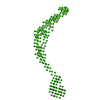
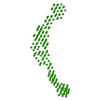
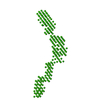
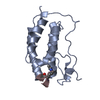
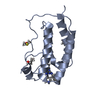
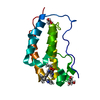

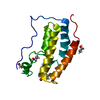
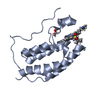
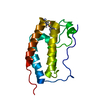
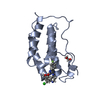
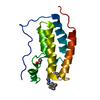



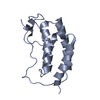
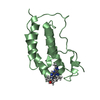

 PDBj
PDBj


















